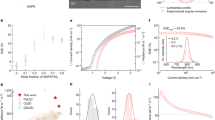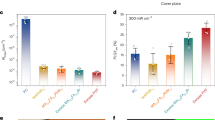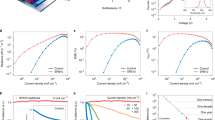Abstract
The thermal quenching of light emission is a critical bottleneck that hampers the real-world application of lead halide perovskite nanocrystals in both electroluminescent and down-conversion light-emitting diodes. Here, we report CsPbBr3 perovskite nanocrystals with a temperature-independent emission efficiency of near unity and constant decay kinetics up to a temperature of 373 K. This unprecedented regime is obtained by a fluoride post-synthesis treatment that produces fluorine-rich surfaces with a wider energy gap than the inner nanocrystal core, yielding suppressed carrier trapping, improved thermal stability and efficient charge injection. Light-emitting diodes incorporating these fluoride-treated perovskite nanocrystals show a low turn-on voltage and spectrally pure green electroluminescence with an external quantum efficiency as high as 19.3% at 350 cd m−2. Importantly, nearly 80% of the room-temperature external quantum efficiency is preserved at 343 K, in contrast to the dramatic drop commonly observed for standard CsPbBr3 perovskite nanocrystal light-emitting diodes. These results provide a promising pathway for high-performance, practical light-emitting diodes based on perovskite nanostructures.
This is a preview of subscription content, access via your institution
Access options
Access Nature and 54 other Nature Portfolio journals
Get Nature+, our best-value online-access subscription
$29.99 / 30 days
cancel any time
Subscribe to this journal
Receive 12 print issues and online access
$209.00 per year
only $17.42 per issue
Buy this article
- Purchase on Springer Link
- Instant access to full article PDF
Prices may be subject to local taxes which are calculated during checkout





Similar content being viewed by others
Data availability
The data that support the findings of this study are available from the corresponding author upon reasonable request.
References
Shamsi, J., Urban, A. S., Imran, M., De Trizio, L. & Manna, L. Metal halide perovskite nanocrystals: synthesis, post-synthesis modifications, and their optical properties. Chem. Rev. 119, 3296–3348 (2019).
Akkerman, Q. A. et al. Strongly emissive perovskite nanocrystal inks for high-voltage solar cells. Nat. Energy 2, 16194 (2016).
Xing, G. et al. Low-temperature solution-processed wavelength-tunable perovskites for lasing. Nat. Mater. 13, 476–480 (2014).
Meinardi, F. et al. Doped halide perovskite nanocrystals for reabsorption-free luminescent solar concentrators. ACS Energy Lett. 2, 2368–2377 (2017).
Gandini, M. et al. Efficient, fast and reabsorption-free perovskite nanocrystal-based sensitized plastic scintillators. Nat. Nanotechnol. 15, 462–468 (2020).
Song, J. et al. Quantum dot light-emitting diodes based on inorganic perovskite cesium lead halides (CsPbX3). Adv. Mater. 27, 7162–7167 (2015).
Pan, J. et al. Highly efficient perovskite‐quantum‐dot light‐emitting diodes by surface engineering. Adv. Mater. 28, 8718–8725 (2016).
Chiba, T. et al. High-efficiency perovskite quantum-dot light-emitting devices by effective washing process and interfacial energy level alignment. ACS Appl. Mater. Interfaces 9, 18054–18060 (2017).
Li, J. et al. 50-Fold EQE improvement up to 6.27% of solution-processed all-inorganic perovskite CsPbBr3 QLEDs via surface ligand density control. Adv. Mater. 29, 1603885 (2017).
Song, J. et al. Room-temperature triple-ligand surface engineering synergistically boosts ink stability, recombination dynamics, and charge injection toward EQE-11.6% perovskite QLEDs. Adv. Mater. 30, 1800764 (2018).
Song, J. et al. Organic–inorganic hybrid passivation enables perovskite QLEDs with an EQE of 16.48%. Adv. Mater. 30, 1805409 (2018).
Yan, F. et al. Highly efficient visible colloidal lead-halide perovskite nanocrystal light-emitting diodes. Nano Lett. 18, 3157–3164 (2018).
Chen, H. et al. Sodium ion modifying in situ fabricated CsPbBr3 nanoparticles for efficient perovskite light emitting diodes. Adv. Opt. Mater. 7, 1900747 (2019).
Dong, Y. et al. Bipolar-shell resurfacing for blue LEDs based on strongly confined perovskite quantum dots. Nat. Nanotechnol. 15, 668–674 (2020).
Xing, J. et al. High-Efficiency Light-Emitting diodes of organometal halide perovskite amorphous nanoparticles. ACS Nano 10, 6623–6630 (2016).
Han, D. et al. Efficient light-emitting diodes based on in situ fabricated FAPbBr3 nanocrystals: the enhancing role of the ligand-assisted reprecipitation process. ACS Nano 12, 8808–8816 (2018).
Chen, H. et al. High-efficiency formamidinium lead bromide perovskite nanocrystal-based light-emitting diodes fabricated via a surface defect self-passivation strategy. Adv. Opt. Mater. 8, 1901390 (2020).
Chiba, T. et al. Anion-exchange red perovskite quantum dots with ammonium iodine salts for highly efficient light-emitting devices. Nat. Photonics 12, 681–687 (2018).
Lee, S. et al. Growth of nanosized single crystals for efficient perovskite light-emitting diodes. ACS Nano 12, 3417–3423 (2018).
Ban, M. et al. Solution-processed perovskite light emitting diodes with efficiency exceeding 15% through additive-controlled nanostructure tailoring. Nat. Commun. 9, 3892 (2018).
Lin, K. et al. Perovskite light-emitting diodes with external quantum efficiency exceeding 20 per cent. Nature 562, 245–248 (2018).
Cao, Y. et al. Perovskite light-emitting diodes based on spontaneously formed submicrometre-scale structures. Nature 562, 249–253 (2018).
Zhao, B. et al. High-efficiency perovskite–polymer bulk heterostructure light-emitting diodes. Nat. Photonics 12, 783–789 (2018).
Xu, W. et al. Rational molecular passivation for high-performance perovskite light-emitting diodes. Nat. Photonics 13, 418–424 (2019).
Lee, H., Ko, D. & Lee, C. Direct evidence of ion-migration-induced degradation of ultrabright perovskite light-emitting diodes. ACS Appl. Mater. Interfaces 11, 11667–11673 (2019).
Palazon, F. et al. Evolution of CsPbBr3 nanocrystals upon post-synthesis annealing under an inert atmosphere. J. Mater. Chem. C 4, 9179–9182 (2016).
Conings, B. et al. Intrinsic thermal instability of methylammonium lead trihalide perovskite. Adv. Energy Mater. 5, 1500477 (2015).
Bachmann, V., Ronda, C. & Meijerink, A. Temperature quenching of yellow Ce3+ luminescence in YAG:Ce. Chem. Mater. 21, 2077–2084 (2009).
Ahn, B.-L., Jang, C.-Y., Leigh, S.-B., Yoo, S. & Jeong, H. Effect of LED lighting on the cooling and heating loads in office buildings. Appl. Energy 113, 1484–1489 (2014).
Wei, Y., Cheng, Z. & Lin, J. An overview on enhancing the stability of lead halide perovskite quantum dots and their applications in phosphor-converted LEDs. Chem. Soc. Rev. 48, 310–350 (2019).
Zhang, F. et al. Brightly luminescent and color-tunable colloidal CH3NH3PbX3 (X = Br, I, Cl) quantum dots: potential alternatives for display technology. ACS Nano 9, 4533–4542 (2015).
Li, X. et al. CsPbX3 quantum dots for lighting and displays: room‐temperature synthesis, photoluminescence superiorities, underlying origins and white light‐emitting diodes. Adv. Funct. Mater. 26, 2435–2445 (2016).
Wei, S. et al. Room-temperature and gram-scale synthesis of CsPbX3 (X = Cl, Br, I) perovskite nanocrystals with 50–85% photoluminescence quantum yields. Chem. Commun. 52, 7265–7268 (2016).
Diroll, B. T., Nedelcu, G., Kovalenko, M. V. & Schaller, R. D. High‐temperature photoluminescence of CsPbX3 (X = Cl, Br, I) nanocrystals. Adv. Funct. Mater. 27, 1606750 (2017).
Zhang, Q. et al. Bifunctional passivation strategy to achieve stable CsPbBr3 nanocrystals with drastically reduced thermal-quenching. J. Phys. Chem. Lett. 11, 993–999 (2020).
Shi, Z. et al. Strategy of solution-processed all-inorganic heterostructure for humidity/temperature-stable perovskite quantum dot light-emitting diodes. ACS Nano 12, 1462–1472 (2018).
Kohn, W. & Sham, L. J. Self-consistent equations including exchange and correlation effects. Phys. Rev. 140, A1133–A1138 (1965).
Wang, N. et al. Perovskite light-emitting diodes based on solution-processed self-organized multiple quantum wells. Nat. Photonics 10, 699–704 (2016).
Shi, H. & Du, M.-H. Shallow halogen vacancies in halide optoelectronic materials. Phys. Rev. B 90, 174103 (2014).
Sebastian, M. et al. Excitonic emissions and above-band-gap luminescence in the single-crystal perovskite semiconductors CsPbBr3 and CsPbCl3. Phys. Rev. B 92, 235210 (2015).
Righetto, M. et al. Hot carriers perspective on the nature of traps in perovskites. Nat. Commun. 11, 2712 (2020).
Li, N. et al. Cation and anion immobilization through chemical bonding enhancement with fluorides for stable halide perovskite solar cells. Nat. Energy 4, 408–415 (2019).
Castelli, I. E., García-Lastra, J. M., Thygesen, K. S. & Jacobsen, K. W. Bandgap calculations and trends of organometal halide perovskites. APL Mater. 2, 081514 (2014).
Li, C. et al. Halide-substituted electronic properties of organometal halide perovskite films: direct and inverse photoemission studies. ACS Appl. Mater. Interfaces 8, 11526–11531 (2016).
Chen, Q. et al. Under the spotlight: the organic–inorganic hybrid halide perovskite for optoelectronic applications. Nano Today 10, 355–396 (2015).
Woo, J. Y. et al. Highly stable cesium lead halide perovskite nanocrystals through in situ lead halide inorganic passivation. Chem. Mater. 29, 7088–7092 (2017).
Empedocles, S. A. & Bawendi, M. G. Quantum-confined Stark effect in single CdSe nanocrystallite quantum dots. Science 278, 2114–2117 (1997).
Di Stasio, F. et al. High-efficiency light-emitting diodes based on formamidinium lead bromide nanocrystals and solution processed transport layers. Chem. Mater. 30, 6231–6235 (2018).
Tan, Y. et al. Highly luminescent and stable perovskite nanocrystals with octylphosphonic acid as a ligand for efficient light-emitting diodes. ACS Appl. Mater. Interfaces 10, 3784–3792 (2018).
Yang, F. et al. Efficient and spectrally stable blue perovskite light-emitting diodes based on potassium passivated nanocrystals. Adv. Funct. Mater. 30, 1908760 (2020).
Acknowledgements
This work was supported by the National Key Research and Development Program (no. 2017YFE0127100), Guangdong Province’s 2018–2019 Key R&D Program (2019B010924001), the National Natural Science Foundation of China (NSFC 21773155), the Shanghai Sailing Program (19YF1422200), the Shanghai Jiao Tong University Scientific and Technological Innovation Funds, and the Engineering Research Center for Nanophotonics & Advanced Instrument, the Ministry of Education, East China Normal University (no. 202001). Financial support from the Italian Ministry of University and Research (MIUR) through grant Dipartimenti di Eccellenza - 2017 ‘Materials For Energy’. We thank the Instrumental Analysis Center of Shanghai Jiao Tong University and the workers (J. Ding, X. Ding, N. Zhang, X. Guo and Y. Han) for their help with XPS, TOF-SIMS and TEM analyses. We also thank H. Song from the School of Chemistry of Sun Yat-sen University for help with the aberration-corrected STEM measurements.
Author information
Authors and Affiliations
Contributions
L.L. conceived this study. M.L. synthesized and characterized the nanocrystals and performed the thermal quenching experiments. Q.W. fabricated and tested the LEDs. H.W. and X.S. performed the DFT calculations. F.C. performed the optical characterization under the supervision of S.B., M.L. and W.Z. with the assistance of Qinggang Zhang; L.K., Qi Zhang and C.Z. performed the structural characterization. L.L. and S.B. analysed the data. S.B. wrote the paper in consultation with all authors. M.L, Q.W. and H.W. contributed equally to this work.
Corresponding authors
Ethics declarations
Competing interests
The authors declare no competing interests.
Additional information
Peer review information Nature Photonics thanks Yangchuan Xing and the other, anonymous, reviewer(s) for their contribution to the peer review of this work.
Publisher’s note Springer Nature remains neutral with regard to jurisdictional claims in published maps and institutional affiliations.
Supplementary information
Supplementary Information
Supplementary Tables 1–4 and Figs. 1–19.
Rights and permissions
About this article
Cite this article
Liu, M., Wan, Q., Wang, H. et al. Suppression of temperature quenching in perovskite nanocrystals for efficient and thermally stable light-emitting diodes. Nat. Photonics 15, 379–385 (2021). https://doi.org/10.1038/s41566-021-00766-2
Received:
Accepted:
Published:
Issue Date:
DOI: https://doi.org/10.1038/s41566-021-00766-2
This article is cited by
-
Spontaneous crystallization of strongly confined CsSnxPb1-xI3 perovskite colloidal quantum dots at room temperature
Nature Communications (2024)
-
Potential and perspectives of halide perovskites in light emitting devices
Nano Convergence (2023)
-
In-situ growth of low-dimensional perovskite-based insular nanocrystals for highly efficient light emitting diodes
Light: Science & Applications (2023)
-
An investigation on the cyclic temperature-dependent performance behaviors of ultrabright air-stable QLEDs
Scientific Reports (2023)
-
Direct in situ photolithography of perovskite quantum dots based on photocatalysis of lead bromide complexes
Nature Communications (2022)



